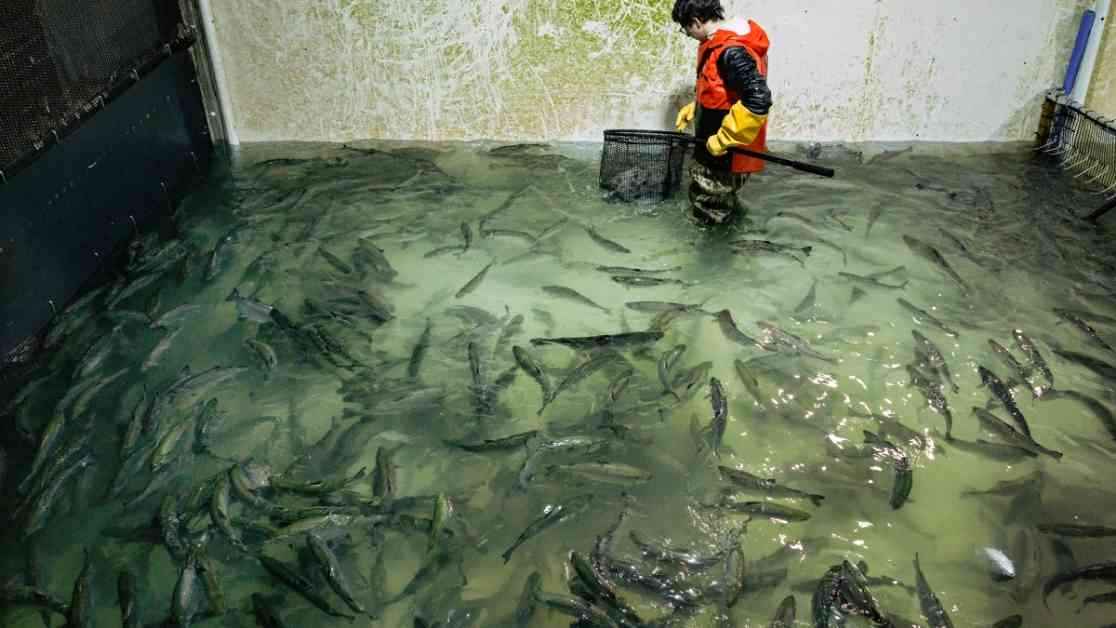In a remarkable display of community spirit and resourcefulness, a New York food bank recently found itself facing a unique challenge – how to process and distribute a massive donation of 13,000 live salmon. The heartwarming story unfolded in the small upstate city of Auburn, where LocalCoho, a salmon farm on the cusp of closure, decided to donate 40,000 pounds of Coho salmon to the Food Bank of Central New York.
The catch, however, was that the salmon were still swimming in the farm’s tanks, requiring a swift and efficient operation to extract them and transform them into frozen fillets for distribution to those in need. As LocalCoho was set to close its doors that very week, time was of the essence.
Thankfully, a team of dedicated food pantry volunteers, along with the food bank’s staff, rose to the challenge. Over the course of a few intense weeks, they managed to empty the tanks and pack the fish for shipment to a processor. Brian McManus, the food bank’s chief operations officer, reflected on the urgency and intensity of the situation, emphasizing the will and expertise of those involved.
The issue of food waste has long plagued the U.S. and the world at large, with over one-third of food produced in the country going uneaten, much of it ending up in landfills. The donation of thousands of pounds of high-quality protein-rich salmon represented a beacon of hope in the fight against hunger and waste.
## A Community Effort: From Tank to Table
On a cold January day, workers at LocalCoho waded through tanks teeming with salmon, filling their nets with the fish that would soon find their way to the food bank. Volunteers like Christina Hudson Kohler donned waterproof gear and gloves, stepping up to the challenge of a different kind of volunteer work.
“It’s a little bit different,” Kohler remarked during a break. “In the past, my volunteer work with the food bank has been sorting carrots or peppers, or gleaning out in the field.” The hands-on nature of this endeavor brought a new dimension to the act of giving back to the community.
LocalCoho, a startup focused on sustainable salmon farming, had been a pioneer in the field, supplying salmon to various outlets with the goal of expanding its operations nationwide. However, financial constraints led to the decision to close shop, prompting the donation of the remaining live salmon to the food bank.
Adam Kramarsyck, the farm manager, expressed a desire to ensure the fish did not go to waste, highlighting the need for creative solutions to unexpected challenges. The team at LocalCoho, along with the food bank, embarked on a race against time to process and distribute the thousands of fish.
## Turning Challenges into Opportunities
The logistics of processing 13,000 live salmon into frozen fillets within a tight timeframe presented a formidable task. The food bank, while well-versed in distributing canned and frozen food, faced a new challenge in handling fresh fish. With the clock ticking, the pressure was on to make the most of this generous donation.
Thanks to the efforts of 42 volunteers, a local business offering free shipping, and the dedication of LocalCoho staff, the salmon made their way to a processor in Rochester. A total of 26,000 servings of protein-rich salmon were destined for distribution to food pantries, soup kitchens, shelters, and other institutions within the food bank’s network.
The impact of this donation, both in terms of nourishment and community support, was set to be substantial. McManus, reflecting on the significance of the donation, noted, “Protein, animal protein is very, very desirable. We know that people need it for nourishment and it’s difficult to get. And so this is going to make a very large impact.” The sense of urgency and collaboration that defined this operation underscored the power of collective action in addressing food insecurity.
“I don’t anticipate this being here very long,” he added. “We’ve had salmon before, but not like this.” The legacy of this massive donation of salmon, from tank to table, would undoubtedly leave a lasting impact on the community it served.


